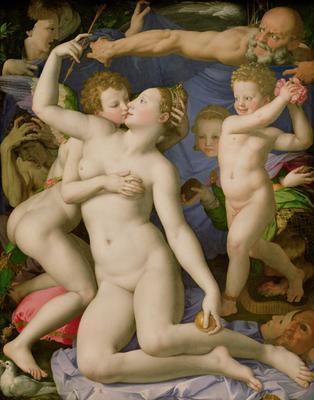With four days to go until Valentine’s Day this week’s debatably appropriate choice of picture is An Allegory with Venus and Cupid, by the sixteenth-century Florentine artist Bronzino. It was probably done for the artist’s principal patron, Duke Cosimo I de Medici, in order to be presented as a diplomatic gift to Francis I, king of France. The painting, which entered the National Gallery from a French private collection, has been plausibly identified with one described by the Renaissance art historian Giorgio Vasari, in his biography of Bronzino: “He made a picture of singular beauty which was sent into France to King Francois I. In it was a nude Venus with Cupid who kissed her, and Pleasure (Piacere) was on one side as well as Jest (Guoco) and other Cupids, and on the other side was Deceit (Fraude), Jealousy (Gelosia) and other passions of love.”
Vasari’s description is neither complete nor fully accurate – he omits, for example, the hoary figure of Father Time at the top – but that can be explained by the fact that he was writing from memory, more than twenty years after the picture had been despatched from Florence to France. In essence, his summary is correct. The painting’s subject is, as he suggests, twofold. “On one side”, it depicts the pleasures of love; “on the other side”, it also reveals its miseries and its pitfalls.
At first glance, Bronzino’s allegory looks like a straightforward “Triumph of Venus”, a theme often treated by Italian Renaissance artists. The goddess is seen in her boudoir, half-reclining on one corner of a plump red cushion amid bedsheets tangled by amorous dalliance. Her son Cupid embraces her. In her left hand, she holds the golden apple given to her by...

ITP 95: Allegory of Venus and Cupid, by Bronzino
10-02-2002

